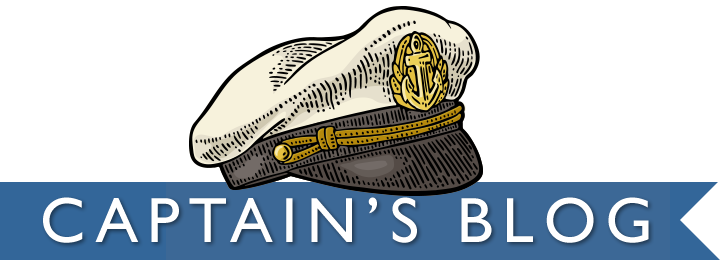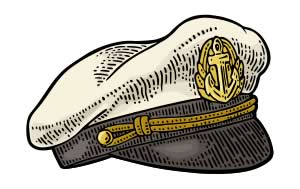It's Monday December 8, 2025

June 2020
Thank you readers for the excellent feedback on the Palm Coast Tragedy. I am glad ya’ll enjoyed it. This month I am making a slight course correction and veering away from entertainment back to helpful. I trust you will still find this help fun. My thoughts on planning:Planning is the primary method for reducing risk. I like to plan and prefer the stubby pencil method. I am uncomfortable cruising somewhere without a plan. You also should be uncomfortable. That angst you are feeling while going to Beaufort means you haven’t planned well enough. And, I don’t mean just a navigation plan.
If all goes well, modern chart plotters make the navigation easy. With one press of the touch screen, your route is completely planned. And, if your boat specifications are properly entered, your route will avoid shallows and the bridges that are too low. The technology inherent in a modern chart plotter has outpaced most navigation classes. Mostly, lines on charts are no longer required. The technology is freeing and wonderful. However, there is a sinister side to this technology. Read on.Here is my point. The planning technology in a chart plotter does not build situational awareness. Blindly following the Intra Coastal Waterway magenta line on the chart plotter is fraught with risk. Captains must execute their own plan, not the plan the chart plotter presents. Captains are responsible for everything that happens and fails to happen aboard their boats. If you have an incident, insurance adjusters will not allow you to deflect responsibility to your chart plotter. Yes; despite its magical capability, your chart plotter will not accept any responsibility. So, I offer my “stubby pencil” tool for developing situational awareness. I use this planning sheet when going somewhere big. And, you can decide what is big. For me, Beaufort is big. And, sometimes New Bern is big. Big is up to you. Here’s how I use the sheet.
(click image for larger view)
Break down the passage into from/to segments. Determine the distance between the endpoints of the route segments. Then, calculate the estimated time enroute (ETE) for each segment at 6 and 7 knots. If your boat is slower use 5 and 6 knots. This method forces chart study. Filling in the sheet makes you look at and mentally travel the route “ahead of time”. Surprises are minimized. When leaving the first point, departure time is noted and estimated time of arrival (ETA) at the first endpoint is calculated. When reaching that endpoint, use the ETE for the next segment and calculate the ETA for the next. So, each leg or segment has its own ETA. Work your way down the sheet calculating the ETAs. This sheet is an excellent “howgozit” tool. Completing the sheet keeps the crew involved. A busy crew is less likely to munity (). Some of our completed sheets are permanent in our ships log. All good.
For this example, I worked the sheet backwards.
In Beaufort, the current rips through Taylor Creek. I want to arrive at slack current. If slack current in Beaufort is 1308 (July 1) and our trip requires 3.5 hours, I will depart the first waypoint (Oriental “1SC”) at 0940. I will check the times passing Adams Creek 1 and the Core Creek Bridge to see if we are on schedule for slack current. Wonderful.
I also know the clearance under the Core Creek Bridge. On 1 July, I should get a push from the ebbing tide in Adams Creek. So, I used 6.5 knots for the timing calculations and rounded to the nearest 5 minutes. So, 3 hours and 30 minutes to Beaufort. Elegant!
Admittedly, a modern chart plotter will give you all of this. However, relying on your chart plotter turns you into a piece of computer firmware. Captains that allow chart plotters to plan routes are deferring responsibilities and assuming risk.
With that said; I often to use an iPad to complete my nav sheet. Garmin, Navionics or Aqua Map applications are all good. I like the chart updates via the internet. Navionics incorporates two thousand updates a day. An Ipad is a good substitute for a chart. But, I pick the route and waypoints. I only allow the application to calculate the headings, distance, times and fuel consumption. Nice. My planning sheet to Beaufort takes 15 minutes to complete. It is time well spent and takes a huge bite out of the docking risk in Beaufort. Pasted below is my sheet for a Neuse Sailing Association rendezvous in Belhaven. I completed this sheet in twenty minutes.
(click image for larger view)
Again, if we’re going somewhere big, I will “do” a nav sheet. I have a plan, three sheets long, to Stuart, Florida. Admittedly, this seems retentive. I accept that. But, when examined with a risk reduction mindset, the time spent is a worthwhile investment. Contact me through my web site and I will email you a blank sheet for your next trip. Plan for success by having a plan.
Fair Winds
Captain John Rahm
“Stubby Pencil Guy”
 Captain's Blog on TownDock.net is all about making your time on the water enjoyable. Captain John Rahm teaches sailing and boat handling at Third Wave Sailing. Captain's Blog on TownDock.net is all about making your time on the water enjoyable. Captain John Rahm teaches sailing and boat handling at Third Wave Sailing. |
